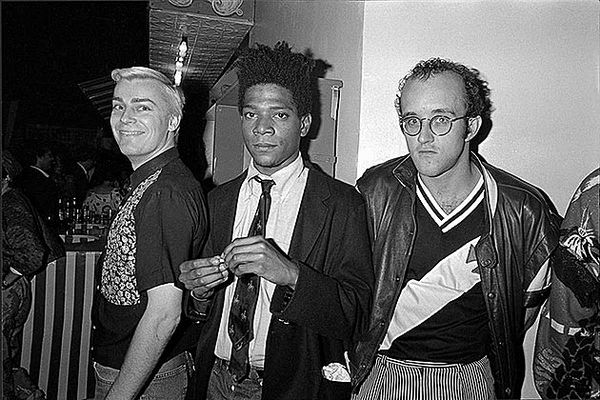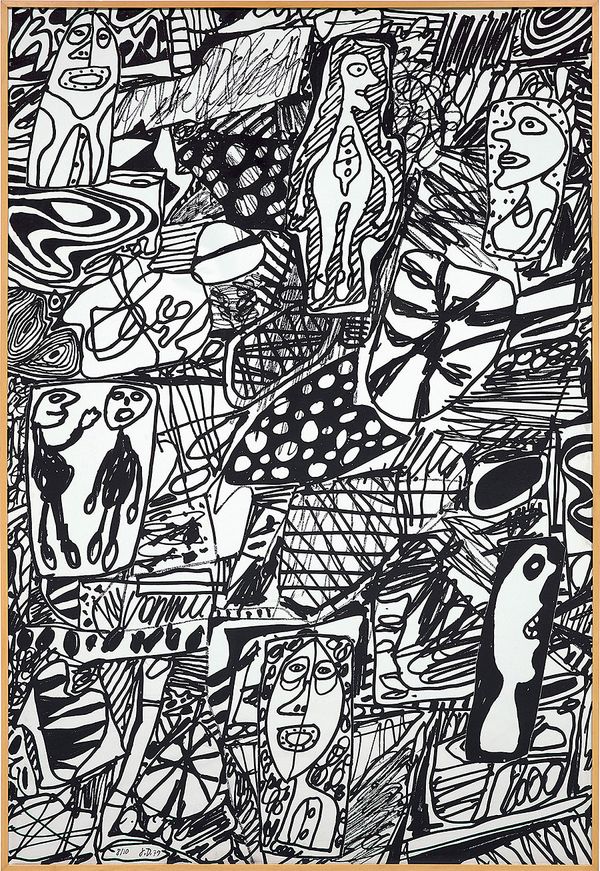Jean Dubuffet, Site de mémoire I (Memory Site I) (L. fasc. XXXII 182b, W. 1262), 1979. Editions & Works on Paper New York.
Written by Isis Davis-Marks
Jean Dubuffet spent nearly four decades upending artistic conventions with his work – his sweeping oeuvre includes everything from sand-encrusted canvases to brightly colored sculptures to animated drawings made from inky lines and splotches. Such pieces placed human emotion above realistic rendering, so Dubuffet turned to graffiti, children’s art, and non- Western designs for their ability to channel our deepest desires and terrors in a way that formal European paintings cannot. The creator coined the term Art Brut—which roughly translates to “raw art”— in 1945 to characterize these unbridled pieces and championed self-taught or “outside” craftspeople who had no academic training.
In 1951, Dubuffet gave a seminal lecture at The Arts Club of Chicago, during which he explained the visceral effects of visual media: “Painting is a far more immediate language than that of written words and at the same time it is charged with far more meaning. It operates with signs that are not abstract or incorporeal like words.”
Dubuffet’s own oils, prints, collages, drawings, and sculptures embodied “instinct, passion, mood, [and] violence” by combining fluid marks, cryptic symbols, and graphic forms that evoke our base emotions; those things that we feel before we’re influenced by academic papers or wall texts or art-world jargon. His pieces are a far cry from the stiff portraits of DaVinci or the mimetic sculptures of Michelangelo. Instead, works like Dubuffet’s Site de mémoire I speak to his wild imagination, and the large-scale print is filled with swirling scribbles, sinuous shapes, and animated figures, making the painting feel like a depiction of a fantastic fever dream that does not abide to the logic of our world.
The artist’s inclination towards commotion and catharsis was also reflected in his choice of supplies: Dubuffet often used uncommon tools and materials like plants, fruit peels, and tapioca, which imbued his collage works with unique textures and compositions. One piece, Soil Ornamented with Vegetation, Dead Leaves, Pebbles, Diverse Debris (1956), included jigsaw puzzle-like shapes awash with earthy hues, creating the sense of organized chaos. “I have a great interest in madness, and I am convinced art has much to do with madness,” Dubuffet said to a separate Chicago audience in 1952.

Keith Haring, Apocalypse Suite (L. pp. 98-109), 1988. Editions & Works on Paper New York.
This Dionysian descent into delusion is what made Dubuffet’s work so alluring. Artists from younger generations, including the luminary painter Jean-Michel Basquiat, who was some 60 years younger than the French artist, and Keith Haring, another creator who was Basquiat’s friend and contemporary, drew inspiration from the Art Brut icon. Though Haring and Basquiat both created distinct works, the two artists created pieces that clearly share commonalities with Dubuffet’s oeuvre. Even a quick glance at Basquiat’s strange and symbolic canvases reveals parallels with Dubuffet’s compositions—By the 1980’s, Basquiat began employing Dubuffet’s signature Art Brut techniques upon seeing works from the postwar painter’s Théâtres de mémoire series (one of the Dubuffet’s last, which he started in 1975) at Pace Gallery in New York. Eventually, the younger artist became so enamored with Dubuffet’s canvases that he asked the then-owner of the gallery, Arne Glimcher, if he could watch art handlers install pieces of Dubuffet exhibitions to “just sit with the work for a few hours.”
After this, Basquiat began to make more overt references to Dubuffet’s images and adopted some of the French artist’s compositional choices. For example, Basquiat’s painting Untitled (1982) shows a striking scene of a figure with devil horns; the subject hovers atop a background splattered with drips of green, pink, red, and white paint. Untitled uses color, line, and composition similarly to Dubuffet’s 1977 work Vicissitudes, a collage that blends figuration with lines and blob-like shapes. Other works, like Pegasus (1987), bear an even stronger resemblance to Dubuffet’s canvases: Basquiat’s enigmatic black-and-white painting uses the same color scheme as his predecessor’s landscape, and that characteristic elevated horizon also appears near the top of his creation.
When Basquiat began showing work, critics easily identified the connections between the two artists. In his seminal Artforum essay “The Radiant Child,” critic Rene Ricard wrote, “If Cy Twombly and Jean Dubuffet had a baby and gave it up for adoption, it would be Jean-Michel. The elegance of Twombly is there but from the same source (graffiti) and so is the brut of the young Dubuffet. Except the politics of Dubuffet needed a lecture to show, needed a separate text, whereas in Jean-Michel they are integrated by the picture’s necessity.” As Ricard points out, Basquiat’s painting stands apart from that of his predecessor’s because it contains a distinctive element: text. The younger artist’s work reads like a schematic diagram with miniscule pictures and words like “STEEL,” “syrup,” and, of course, the title of the painting itself. “It’s as if [Basquiat] were dripping letters,” the renowned art historian Robert Farris Thompson once wrote when describing Pegasus.

John Sex, Jean-Michel Basquiat, and Keith Haring, 1984. Image: © Ben Buchanan
Much like Basquiat, Keith Haring also acknowledged the connections between his work and Dubuffet’s, though Haring seemed to come to this epiphany after he began to paint in such a semiotic style. “I spent a lot of time at the library and came across Dubuffet,” Haring told John Gruen, as quoted on the Keith Haring Foundation website. “I was startled at how similar Dubuffet’s images were to mine, because I was making these little abstract shapes that were interconnected. So, I looked into the rest of his work.” Throughout his life, Haring continued to integrate text and political statements into his work, and other works like Ignorance=Fear (1989) commented on the AIDS crisis in a way that was evocative and immediate, much like Basquiat’s King Zulu or Dubuffet’s Site de mémoire I.
Haring’s Apocalypse Suite (1988), shows a set of 10 screenprints filled with expressive lines, splotches of saturated colors, and references to Renaissance paintings like the Mona Lisa. Created in collaboration with author William S. Burroughs, the Apocalypse project offers a visual representation of the cultural and artistic landscape of New York at the height of the AIDS epidemic. Each image is paired with a text written by Burroughs, whose automatic writing style offers a textual context to Haring’s provocative visions of end times and his own diagnosis. The artist’s nods to both fine art and popular culture seem aligned with the principles of Art Brut, and Haring continued to push the boundaries of what could be considered fine art throughout his career. Unlike Haring and Basquiat, Dubuffet shied away from using such semantic characters in his work because he viewed “painting is a far richer language than the language of words,” as he stated in his 1951 Arts Club speech.
Still, both Haring and Basquiat reference Dubuffet in their respective oeuvres: If you view Basquiat’s Pegasus from a distance, the tiny letters in begin to look like Dubuffet’s blobs, and works from Dubuffet’s Théâtres de mémoire series employ color in a way that’s similar to Haring’s screenprints in Apocalypse Suite. This probably wasn’t a mistake on Basquiat’s part—the artist may have seen Dubuffet’s Landscape (Paysage) when it was exhibited at the Museum of Modern Art in 1987, which could explain the striking compositional similarities between the two pictures.
All three artists also created heady, vibrant depictions of cities: Dubuffet rendered colorful abstractions of Paris in his painting Paris Circus (1971); Basquiat paid homage to his birthplace, New York, in works like City Taxi; and Haring referenced aspects of city life in murals like Crack is Wack. But one of the most poignant links between all three painters was their ability to upend conventions by challenging artistic standards and redefining what beautiful art looks like.
“For Dubuffet, it was always about disruption,” Oliver Shultz, Pace’s current curatorial director, told Artnews in a 2020 article. “Disrupting the normal circuits of your ability to perceive the world around you.”
Discover More from Editions & Works on Paper >
Recommended Reading
Editions from the Anderson Family Collection >
